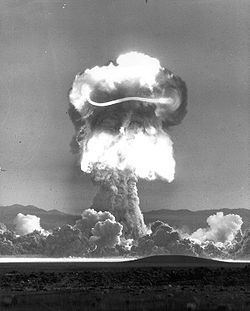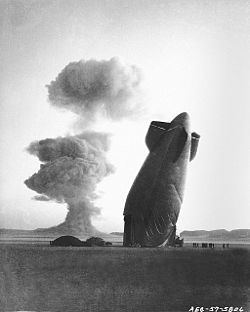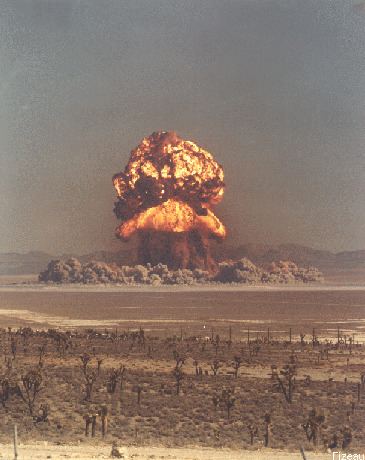Country United States Number of tests 29 | Period 1957 Dates 28 May 1957 – 7 Oct 1957 | |
 | ||
Test site NTS Area 12, Rainier Mesa; NTS Areas 5, 11, Frenchman Flat; NTS, Areas 1-4, 6-10, Yucca Flat Test type balloon, dry surface, high alt rocket (30–80 km), tower, underground shaft, underground tunnel Max. yield 74 kilotonnes of TNT (310 TJ) | ||
Operation Plumbbob was a series of nuclear tests conducted between May 28 and October 7, 1957, at the Nevada Test Site, following Project 57, and preceding Project 58/58A. It was the biggest, longest, and most controversial test series in the continental United States.
Contents
- Operation plumbbob military effects studies doe video 0800022
- Background
- Radiological effects
- Propulsion of steel plate cap
- References

Operation plumbbob military effects studies doe video 0800022
Background

The operation consisted of 29 explosions, of which only two did not produce any nuclear yield. Twenty-one laboratories and government agencies were involved. While most Operation Plumbbob tests contributed to the development of warheads for intercontinental and intermediate range missiles, they also tested air defense and anti-submarine warheads with smaller yields. They included forty-three military effects tests on civil and military structures, radiation and bio-medical studies, and aircraft structural tests. Operation Plumbbob had the tallest tower tests to date in the U.S. nuclear testing program as well as high-altitude balloon tests. One nuclear test involved the largest troop maneuver ever associated with U.S. nuclear testing.

Approximately 18,000 members of the U.S. Air Force, Army, Navy and Marines participated in exercises Desert Rock VII and VIII during Operation Plumbbob. The military was interested in knowing how the average foot-soldier would stand up, physically and psychologically, to the rigors of the tactical nuclear battlefield.

Almost 1,200 pigs were subjected to bio-medical experiments and blast-effects studies during Operation Plumbbob. On shot Priscilla (37 kt), 719 pigs were used in various experiments on Frenchman Flat. Some pigs were placed in elevated cages and provided with suits made of different materials, to test which materials provided best protection from the thermal radiation. As shown and reported in the PBS documentary Dark Circle, the pigs survived, but with third-degree burns to 80% of their bodies. Other pigs were placed in pens behind large sheets of glass at measured distances from the hypocenter to test the effects of flying debris on living targets. Studies were conducted of radioactive contamination and fallout from a simulated accidental detonation of a weapon; and projects concerning earth motion, blast loading and neutron output were carried out.

Nuclear weapons safety experiments were conducted to study the possibility of a nuclear weapon detonation during an accident. On July 26, 1957, a safety experiment, Pascal-A, was detonated in an unstemmed hole at NTS, becoming the first underground shaft nuclear test. The knowledge gained here would provide data to prevent nuclear yields in case of accidental detonations–for example, in a plane crash.

The John shot on July 19, 1957 was the only test of the Air Force's AIR-2 Genie missile with a nuclear warhead. It was fired from an F-89 Scorpion fighter over Yucca Flats at the NNSS. On the ground, the Air Force carried out a public relations event by having five Air Force officers and a photographer stand under ground zero of the blast, which took place at between 18,500 and 20,000 feet altitude, with the idea of demonstrating the possibility of the use of the weapon over civilian populations without ill effects. In 2012 the photographer and the last survivor of the five met in a restaurant in Dallas to reminisce. The five officers were: Colonel Sidney C. Bruce, later professor of Electrical Engineering at Colorado University, died in 2005; Lieutenant Colonel Frank P. Ball, died in 2003; Major John w. Hughes II, died in 1990; Major Norman B. Bodinger, died February 2, 1997; Major Donald A. Luttrell, died in December 20, 2014. The photographer, Akira "George" Yoshitake, died in October 2013.
The Rainier shot, conducted September 19, 1957, was the first fully contained underground nuclear test, meaning that no fission products were vented into the atmosphere. This test of 1.7 kt could be detected around the world by seismologists using ordinary seismic instruments. The Rainier test became the prototype for larger and more powerful underground tests.
Some images from Upshot-Knothole Grable were accidentally relabeled as belonging to the Priscilla shot from Operation Plumbbob in 1957. As a consequence many publications including official government documents have the photo mislabeled.
Radiological effects
Plumbbob released 58,300 kilocuries (2.16 EBq) of radioiodine (I-131) into the atmosphere. This produced total civilian radiation exposures amounting to 120 million person-rads of thyroid tissue exposure (about 32% of all exposure due to continental nuclear tests).
Statistically, this level of exposure would be expected to eventually cause between 11,000 and 212,000 excess cases of thyroid cancer, leading to between 1,000 and 20,000 deaths.
In addition to civilian exposure, troop exercises conducted near the ground near shot Smoky exposed over 3000 servicemen to relatively high levels of radiation. A survey of these servicemen in 1980 found significantly elevated rates of leukemia: ten cases, instead of the baseline expected four.
Propulsion of steel plate cap
During the Pascal-B nuclear test, a 900-kilogram (2,000 lb) steel plate cap (a piece of armor plate) was blasted off the top of a test shaft at a speed of more than 66 km/s (41 mi/s; 240,000 km/h; 150,000 mph). Before the test, experimental designer Dr. Brownlee had estimated that the nuclear explosion, combined with the specific design of the shaft, would accelerate the plate to approximately six times Earth's escape velocity. The plate was never found, but Dr. Brownlee believes that the plate did not leave the atmosphere, as it may even have been vaporized by compression heating of the atmosphere due to its high speed. The calculated velocity was sufficiently interesting that the crew trained a high-speed camera on the plate, which unfortunately only appeared in one frame, but this nevertheless gave a very high lower bound for its speed. After the event, Dr. Robert R. Brownlee described the best estimate of the cover's speed from the photographic evidence as "going like a bat out of hell!"
